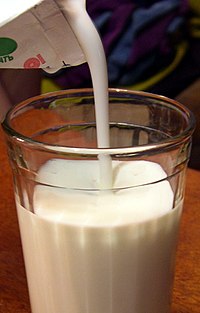
Photo from wikipedia
Abstract Infectious disease-causing pathogens can be transmitted via contact with contaminated environmental surfaces (i.e., fomite transmission). However, the physical mechanism of fomite transmission remains unclear because of a lack of… Click to show full abstract
Abstract Infectious disease-causing pathogens can be transmitted via contact with contaminated environmental surfaces (i.e., fomite transmission). However, the physical mechanism of fomite transmission remains unclear because of a lack of suitable surrogate tracers. In this study, the non-toxic, non-human-origin and gram-positive bacterium Lactobacillus delbrueckii subsp. Bulgaricus was selected as a tracer, and its applicability for studying bacterial contamination spread on environmental surfaces was investigated in an office setting. After bacterial introduction by a designated carrier, surface contamination levels indicated by the L. bulgaricus proline iminopeptidase (pepIP) gene copy numbers were quantified using an optimized qPCR assay. This qPCR assay exhibited a high sensitivity (55 copies per reaction mixture and 1585 copies per surface sample), a wide dynamic range (7 orders of magnitude) and a high specificity for pepIP gene in environmental surface samples. Three independent, natural and unsupervised field experiments involving human participants confirmed the applicability of L. bulgaricus as a tracer in field studies and the pepIP gene as a unique marker of externally introduced contamination. Experimentally, contamination was distributed nearly equally over public surfaces, the carrier's seat location and the other seat locations in the office setting. An analysis by seat location revealed that the contamination level was attenuated as the physical distance from the carrier's seat location increased. Volunteers' faces were ubiquitously contaminated, suggesting a potentially high risk of fomite exposure via mucous membranes. In conclusion, L. bulgaricus can feasibly be used as a tracer organism in future large-scale field studies of bacterial contamination spread on environmental surfaces.
Journal Title: Building and Environment
Year Published: 2021
Link to full text (if available)
Share on Social Media: Sign Up to like & get
recommendations!